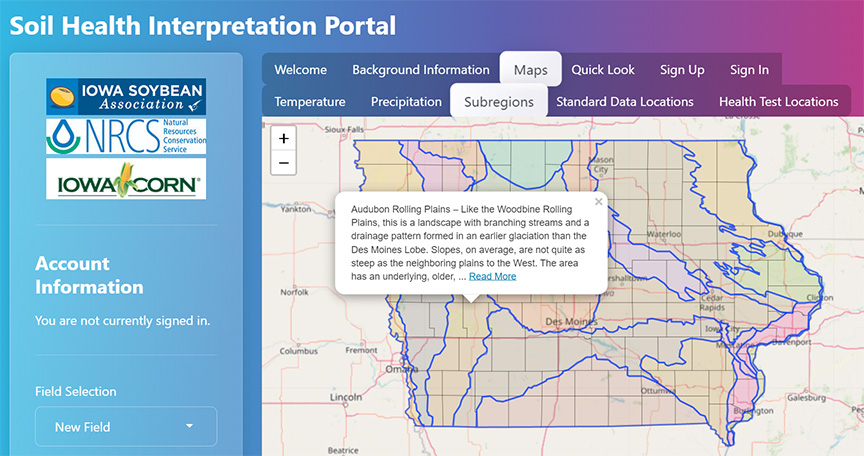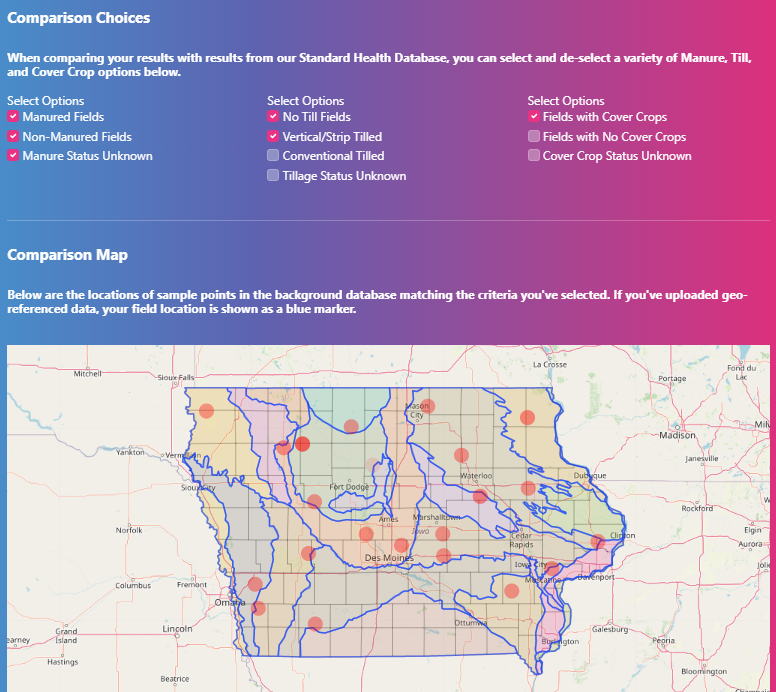
(Photo: Iowa Soybean Association)
How does your soil score?
January 24, 2023
How does soil health testing differ from soil fertility testing? To what extent does regional and glacial history determine differences in modern agricultural soils? Can we benchmark and track progress on Iowa’s overall soil health? Are there tests that can measure the agricultural performance of our soils relative to their optimal capacity?
The Iowa Soybean Association (ISA) Research Center for Farming Innovation (RCFI) Analytics team has compiled a benchmark database of soil health and soil fertility test results. The database is expandable, meaning that additional soil test results from farmers, agronomists and landowners can be uploaded, and if willing, anonymously donated to expand the secure dataset. Spatial references, date of test, and management information regarding tillage, cover crop usage, and manure application status are required for data donations.
The Soil Health Interpretation Portal (SHIP) initial benchmark database is an anonymous conglomeration of lab results from soil health studies conducted by ISA in conjunction with results from Iowa Corn Growers collaborative multi-year Soil Health Partnership program. Statewide results of ISA’s 2011 Nutrient Benchmarking program are also included as part of the standard soil test background dataset, giving visitors a snapshot of soil metrics from a decade ago.
The site provides brief explanations of the basic soil health metrics being tracked in the portal. Lab results are summarized by sub-region with similar topography and soil structure. Visitors to the site can learn about Iowa’s physiographic sub-regions and the characteristics that may impact soil health in each. Sub-regions are identified on an interactive map with links to descriptions of soil history and composition.

Get a lay of the land
Through the “Quick Look” feature, visitors can explore the benchmark databases, with or without uploading or donating their own soil test data. The tool provides opportunities to compare different combinations of three influential management practices on summarized test results for Iowa’s different physiographic subregions.
Visitors who upload spatially referenced soil test results will enable the tool to generate a report for them of “Soil Health Assessment Protocol and Evaluation” or “SHAPE” scores for each sample location with no requirement to donate the data or include any management information, just the option to do so. These scores use 30-year average weather and underlying soil structure and texture to compute a score of how well each sample area is functioning compared to its full potential.
While the portal offers information about ways to improve the results of tested soil health metrics, retention of topsoil is perhaps the most effective way to maintain soil productivity. No-till farming, cover crop incorporation are effective practices to help retain Iowa’s rich topsoil. They also, along with manure application, provide beneficial conditions for microbial actions in the soil to sustain agricultural production.
Analyses are underway to present illustrations and descriptions of what can be observed in the data so far. As the database grows, we will enable summarization options in smaller regional units. Our goal is to study Iowa’s soil health patterns over time while tracking the impact of management practice systems on results.
The portal is available here: https://shportal.iasoybeans.com
Back